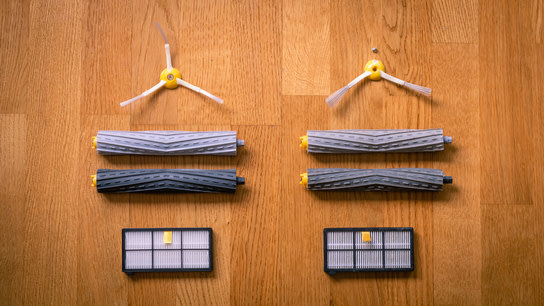The genuine Roomba 900-series replenishment kit (iRobot Authentic-branded) contains a set of debris collectors, two side-brushes, and three air-filters. These are the consumable parts that regularly need replacing on a Roomba. The kit costs about 50 USD in the USA and 70 USD in Europe and Australia. Off-brand versions of the kit are available on Amazon and AliExpress for around 12 USD.
I’ve bought and tested one set of genuine replacements and two different off-brand sets. The two off-brand sets only had minor visual differences so I’ll discuss them as one throughout this article. I hope they’re representative of the experience you might have with off-brand replenishment kits. There are many off-brand manufacturers and sellers and the quality may vary. It’s impossible to know whether you’ll get the same off-brand replacements parts, though.
When buying off-brand parts, I was mostly worried about the quality of the air filters compared to the genuine ones. The genuine AeroForce High-Efficiency Filter from iRobot sounds impressive and is seemingly meant to be associated with a High-efficiency particulate air (HEPA) filter. The term HEPA filter is mostly meaningless in consumer products as there is no HEPA-filter compliance certification for consumer-grade products. The off-brand filters are often labeled as being HEPA filters. The retail packaging for iRobot’s filters clarifies that their filters are what iRobot creatively calls HEPA-style.
There are newer and more concrete standards meant for consumer products. Strangely enough, neither iRobot nor any of the off-brand manufacturers label their products with any of these standards. With the off-brand filters, you never know what filter media you’ll get. It could potentially be a simple piece of pierced cardboard. You don’t much about the quality of the iRobot filters either, though.
I don’t have the testing equipment or experience to say anything definitive about the quality of either filter. You probably wouldn’t be able to obtain the same off-brand filters even if I were able to test them properly. On the other hand, I don't have any evidence for the performance of the genuine filters, either.
It’s better to periodically replace the filters even if that means using the off-brand filters. Get the genuine filters if you feel more comfortable with them, or if you have allergies. Don’t attempt to wash and reuse the filters! You’ll damage the filter media and reduce their efficiency.
Some resellers are claiming that their Roomba-compatible filters are washable. These claims are probably hogwash. In my research, every product listing for a washable filter also recommended replacing the filter every two–four months. Washable filters must be made of a more permanent filter media — like metal — that won’t be damaged by the cleaning process. I haven’t found any metal filters (sometimes called “permanent filters”) for the Roomba 900-series.
The most noticeable quality difference between the two sets were the debris collectors. These are the two rubber roller-brushes that are used to scoop up larger particles and feed them into the air intake underneath the Roomba. The outer shell (including the rubber tracks) on the off-brand debris collectors are made of a softer rubber compared to the genuine ones. The harder material gives the genuine version a firmer grip that makes them better at scooping debris off the floor. However, the more flexible off-brand rollers don’t meet as much resistance when navigating over doorsteps so they may last longer.
The debris collectors are filled with a rubber foam. The off-brand ones have less of this foam and there’s a small gap between the other rubber shell and the foam. This makes them perceptually louder than the genuine debris collectors. I can definitely hear the difference but it’s not a big problem. You likely run your Roomba when you’re not at home, anyway.
The off-brand side-brushes are slightly less flexible than the genuine version. This could indicate that genuine brushes would last longer. In my experience, the brush-arms on both the genuine and off-brand side-brushes break off after about the same number of weeks. I don’t have any reason to believe there is any performance difference between the different brushes.
The genuine side-brushes come with retentive screws (screws that stay in place when it’s not assembled.) The off-brand ones come with loose screws and you may misplace them in the months you’ll store them in your junk drawer. You can reuse the screw already installed in the Roomba, however.
Overall, I don’t see any strong case for spending the extra money on the genuine iRobot Authentic-branded replacement parts. The differences between the genuine replacement parts and the off-brands are small. You may want to purchase the authentic filters if you want to be sure you get the same level of quality — whatever that may be — every time. Save your money when replacing the other parts.
